 |
| Industrial
Development Base |
|
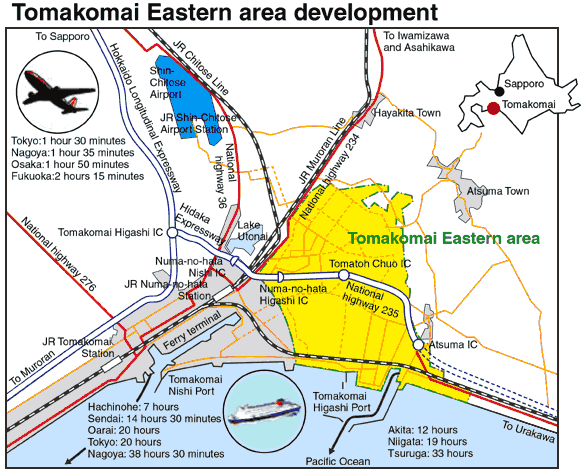 |
The project to develop the eastern
Tomakomai area started in 1971 as a pacesetting development enterprise used
to set in motion the as the long-term development of Hokkaido. With this
development a new development base for industrial production of Japan was
created, contributing to the reorganization of country.
This vast area containing about 10,000 ha (hectares) of inexpensive
land is blessed with excellent traffic conditions in land, sea, and sky,
such as the Shin-Chitose Airport, the Tomakomai harbor, an elevated standard
highway, and railroad. Moreover, the area is favored also by the natural
environment and weather conditions. Furthermore, it is located in the central
part of Hokkaido where advanced city and industrial functions are congregated
and is an area where the possibility for development is very high.
The Hokkaido Development Agency (at that time) decided to start
the Tomakomai eastern development new plan in August 1995 and the way to
further the eastern Tomakomai development project in March 1997, revising
the statement of principles based on basic conventional industrial resources.
These plans promote complex development which combines the functions of
production development, research-and-development, and habitation / life
functions in one. |
| Conditions of the Tomakomai
Eastern Area and Infrastructure Development |
| · |
Mooring facility (Public):
| |
East Waterway, -12m Quay 1 berth
(service from 1992)
Central Waterway, -10m Quay 2 berths (service from 1987) |
|
| · |
Outlying facilities: East breakwater 4,750m,
etc., completed |
|
| · |
Elevated standard highway, Hidaka Expressway:
H10 partially open (appx. 20km in Tomatoh area) |
| · |
Shizukawa-Misawa prefectural route, Shin-Chitose
Airport line: service in progress |
|
| · |
Currently supplied from Tomakomai area
No.2 industrial water |
|
| · |
Major participating companies
| |
Hokkaido Electric Power Co., Inc.,
thermal power station, oil stockpiles (2 companies), call center,
Isuzu Engine Manufacturing, Hokkaido, Ltd., and other manufacturing
industries, logistics related companies, etc.
Tomakomai City Techno Center (industrial technology advancement
support), SANIX Energy, Inc. |
|
| · |
Facilities
| |
Cold region test road, construction
test field (Independent Administrative Institution Civil Engineering
Research Institute of Hokkaido)
Animal quarantine (Ministry of Agriculture, Forestry and Fisheries
of Japan)
Tomakomai district environment monitoring center (Hokkaido) |
|
|
| Future development making
use of development possibilities |
The direction of the future community
development is to promote priority development of inland and the seacoast
areas where companies are already located and infrastructure improvement
has been made. Moreover, the direction of community development is introducing
various functions to respond to comprehensive development, or giving priority
to the advancement of improved infrastructure efficiency.
Plans for the inland Kashiwabara area near the airport include
forming a main operating area for the congregation of industrial operations,
assisted living, etc., as well as the accumulation of research-and-development
and habitation facilities.
In the vast lowland area along the seacoast, this plan promotes
land use to respond to the growing demand for physical distribution focusing
on accumulation of a harbor functions, various industries, research activities,
etc., etc. |
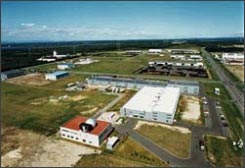 |
The factory
location situation
(Kashiwabara airport area) |
|
 |
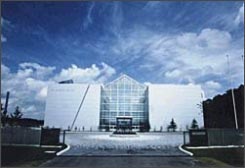 |
Tomakomai
Techno Center
(Kashiwabara airport area) |
|
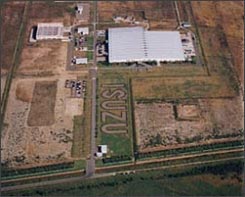 |
Isuzu Engine
Manufacture Hokkaido, Inc.
(Seaside North area) |
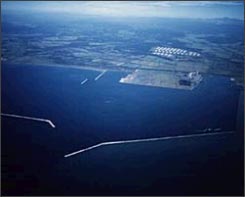 |
Tomakomai
Port Higashi-Minato area
(Seaside port, seaside East and seaside West areas) |
|
 |
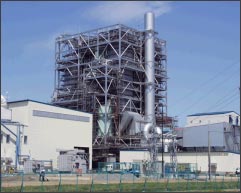 |
Sanix Energy
Tomakomai Plant
(East seaside area) |
|
|
| Tomakomai eastern area development
history |
| May |
1969: |
New Comprehensive National Development
Plan cabinet endorsed by the Cabinet |
| August |
1971: |
Tomakomai Eastern area Large-scale Industrial
Base Development Master Plan formulated |
| July |
1972: |
Tomakomai Eastern Area Development Incorporated
established |
| August |
1995: |
Tomakomai Eastern Area Development New
Plan formulated |
| July |
1999: |
Tomatoh, Inc. established |
|
| Excellent land, sea, and
sky traffic conditions |
| Eastern Tomakomai area (access from Kashiwabara
airport area) |
| · |
To Shin-Chitose Airport for connections
to many cities inside and outside the country, about 15 minutes by
car. |
| · |
To Tomakomai Nishi harbor where a fast
ferry and an international container ship commute to Tokyo, about
15 minutes by car. |
| · |
Tomakomai harbor (West Port area, East
Port area) is connected also to domestic cities including Tokyo and
many cities overseas. (Photo 1) |
| · |
Tomakomai Minato East Port area dolphin
where a 100,000t crude-oil tanker can anchor, and a pier where an
80,000t vessel can come alongside. |
| · |
Hidaka Expressway interchange, with 60
minute access to Sapporo, is located in the center of the area. (Photo
2) |
| · |
To JR Tomakomai Station, the basic passenger
and cargo rail connection with Honshu, about 20 minutes by car. |
| · |
Possibility of constructing a logistic
network using various transportation modes, airports, ports, highways,
and railroads. |
|
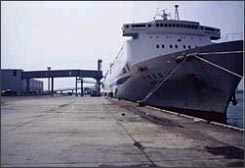 |
Photo 1
Ferry moored at Tomakomai Port
(East Port area) |
|
 |
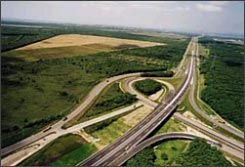 |
Photo 2
Elevated standard expressway
(Hidaka Expressway)
(Kashiwabara airport area) |
|
|
| Good weather conditions and
abundant nature |
| · |
This area of Hokkaido is warmest in winter
and has the least snow. There is no rainy season in summer and the
fresh climate reminds one of Karuizawa. |
| · |
In this area there still remains good,
green land tracts and rivers. Also, the area is close Utonai Lake
designated as a wild bird sanctuary. (Photo 3 and 4) |
|
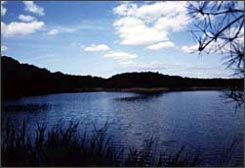 |
Photo 3
Hirakinuma lakes
(East airport area) |
|
 |
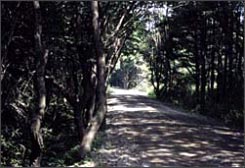 |
Photo 4
The Green tunnel leads to
Tomatoh observatory
(Kashiwabara airport area) |
|
|
| Urban facilities of Mother
City Tomakomai and Sapporo |
| · |
Tomakomai City is fully equipped with
a city facilities such as medical, welfare, educational, and cultural
which are necessary for everyday life.
(Photo 5 and 6) |
| · |
Moreover, Tomakomai is near Sapporo, the
center of Hokkaido politics, economy, and culture. |
|
 |
Photo 5
Oji General Hospital
(Tomakomai City) |
|
 |
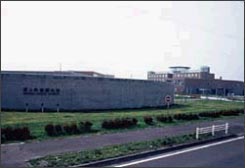 |
Photo 6
Tomakomai Komazawa University
(Tomakomai City) |
|
|
| Eastern Tomakomai New Development
Plan (August 1995) |
A fundamental design aimed at the
formation of an ideal base for industrial and technological interchange
the 2020s in the abundant natural setting of the eastern Tomakomai with
its advanced city facilities.
 Assumed
fields Assumed
fields |
Industrial Field: |
new materials, multimedia, recycling,
energy resources, cryogenic temperature application, etc. |
| |
Academic Field: |
including a public test and research institute,
research and development facilities such as demonstration and experiment
facilities |
| Living and Leisure
Field: |
Aid Service Industry for the support of
industries and living, leisure industry, retail trade industries,
etc. |
 Planned
area: Planned
area: |
10,700 hectares |
|
| 1. |
Establishment
|
| 2. |
Principle equity participants
| |
Development Bank of Japan, Hokkaido
government, Tomakomai City, Atsuma Town, Hayakita Town, and
commercial financial institutions and the private enterprises
in Hokkaido |
|
| 3. |
Contents of the enterprise
| |
Acquisition and reclamation of inexpensive
land in eastern Tomakomai area, sale of lots, leasing, management,
etc. |
|
| 4. |
Location
|
|
| Ishikari Bay New Port area
development |
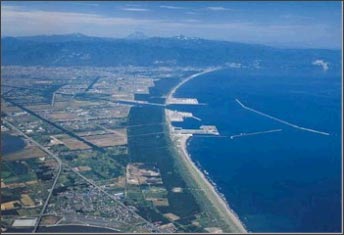 |
| Ishikari Bay
New Port area |
|
| Creation of a new logistics
and production base in the Sapporo-Otaru bloc |
The Ishikari Bay new port area
development is a project to develop a new logistics and production base
in response to logistics increase and expansion of the scale of production
in the Sapporo and Otaru bloc which is the brain of Hokkaido. Also this
project bears the role of an interchange base for northern area countries
expected to grow in the future.
The development of this area along the 3000ha area of the Ishikari
Bay (15km or 30 minutes by car from the center of Sapporo urban area) is
for the purpose of building a logistics base with the port as center, combining
land and sea transport. The master plan for the including the development
of a rich industrial base in the luxurious natural surroundings of this
area and was decided upon in 1972. |
| The situation of the Ishikari
Bay New Port area |
| Infrastructure improvement |
Harbor
| · |
Mooring facilities (public):
| |
East Pier -10m quay 1 berth and
-7.5m quay 2 berths |
| |
Kahan Pier -10m quay 2 berths and
-7.5m quay 3 berths |
| |
Tarukawa Pier -10m quay 2 berths
and -7.5m quay 3 berths |
|
| · |
Outlying facilities: Completion of a 4,500m
north breakwater. |
Road
| · |
National highway 337: Service beginning
1989 |
| · |
National highway 231: Service beginning
1990 |
| · |
Roadside parks along municipal roads,
waterworks for industrial use, sewers, etc., are steadily being improved. |
|
| Gaining momentum of companies entering the
area |
Company advance - In recent years,
collective organization cooperatives representing the logistic industry,
machine and metal related industries, and housing industries from the Sapporo
bloc have entered the region
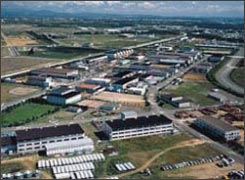 |
| Continued entry
of companies |
In 1994, a marine product processing cryogenic logistic center
was completed and in 1996 an oil terminal was completed in the New Port
central area. There is continuing development of the concentration of a
variety of industries in the area. |
|